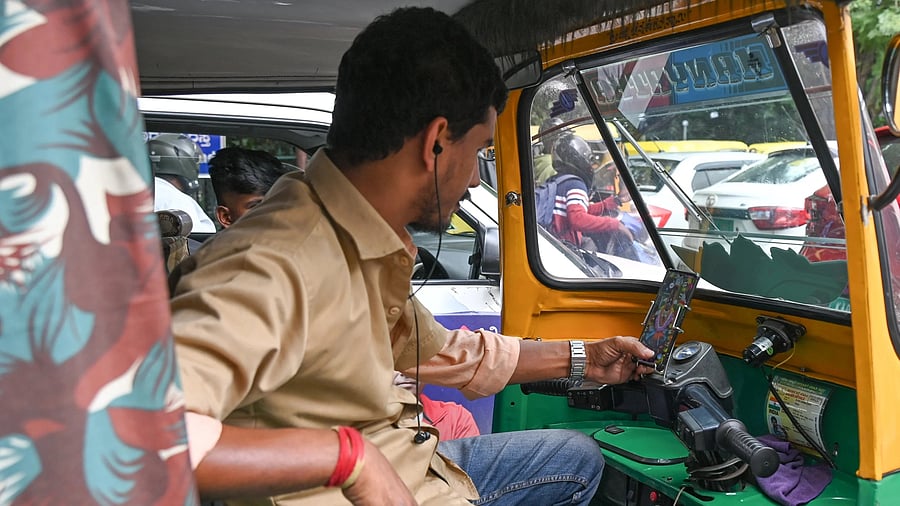
Representative image.
Credit: DH File Photo
Bengaluru could reach a population of ~25 million by 2035. As a top-five FMCG market and a major e-commerce hub, the city is experiencing robust economic expansion, with a projected GDP growth of 8.5% by 2035.
This growth has driven a rapid increase in urban freight activities, fuelled mainly by the rise of e-commerce, quick commerce, retail, manufacturing, MSMEs, and businesses across scale. These sectors together represent the backbone of Bengaluru’s consumption economy, where efficient logistics and goods transportation systems are critical for competitiveness.
As Bengaluru hurtles towards a hyper-connected, commerce-driven future, the demand for fast, efficient, and affordable last-mile goods transportation is exploding. Current goods transportation models rely heavily on cargo vehicles (300-700 kg) or two-wheelers (up to 20 kg). The demand, however, does not reflect the city's vehicular landscape, where autos are ubiquitous, and critical to mobility and goods transportation services with the existing vehicle mix.
This mismatch creates a significant gap in the underserved cargo segment, particularly in the 20-250 kg category, critical for businesses across sectors. Rather than increasing the number of goods carriage/cargo vehicles, reallocating existing vehicle capacity is crucial to reducing congestion, and maintaining competitive logistics costs across industries.
The city’s roads are already congested (vehicle density increased from 761 vehicles/km in 2023-2024 to 823 vehicles/km in 2024-2025). Goods carriage/cargo vehicles often clog residential lanes, reducing average speeds by 15-20 km/h, while logistics providers race to keep pace with soaring demand. Amid this logistical gridlock, a quieter and underutilised solution exists: the autorickshaw.
It is time to reimagine the city’s last-mile logistics with autorickshaws as a key intermediary.
Dual use of autorickshaws
Passenger autorickshaws offer an innovative and scalable solution. Already designed for urban mobility, they can be effectively leveraged for small freight transportation. Passenger autorickshaws typically carry an average load of up to 400 kg (including the driver and passengers) and are primarily intended for short, intra-city trips. When repurposed for logistics, they can reduce costs for businesses of all sizes and sectors, improve vehicle utilisation, lower emissions per trip, and provide an additional income pathway for auto drivers. Dual use of auto rickshaws will not impact peak hours passenger movement as drivers will be involved in good transportation during their idle hours.
A WRI survey on the viability of using autorickshaws for urban freight in India indicates that dual utilisation can address freight supply gaps while providing drivers with an additional income stream. The survey estimates that dual use could increase driver earnings by approximately 15% and reduce CO₂ emissions by 51.5% per trip. It also reports that 72% of drivers in cities such as Bengaluru, Delhi, and Hyderabad already perform dual trips, suggesting high feasibility and acceptance.
Scaling this practice could, therefore, reduce logistics costs not only for MSMEs but also for e-commerce, manufacturing, retail, and service industries alike.
Regulatory barriers to dual use
Under the Motor Vehicle (MV) Act of 1988, autorickshaws are categorised as passenger vehicles. Section 192A imposes penalties for violating permit conditions, while Section 66 mandates the need for a separate goods permit. Furthermore, Type Approval Certificates restrict autorickshaws to passenger-only use.
However, the MV Amendment Act (2019) provides a pathway for reform. Section 63(3) empowers state governments to modify permits for traffic and transport improvements, and precedent exists, such as in Hassan Koaya v Transport Commissioner (2013), the Kerala High Court ruled that vehicles not originally designed for goods have been legally adapted. This provision opens the door for dual licensing, allowing drivers to switch between passenger and cargo operations legally.
For Bengaluru’s 2 lakh registered autorickshaws, this reform can unlock immense economic and environmental potential. It would optimise existing transport assets, support multi-sector logistics efficiency, and generate additional income for driver-partners, all without adding new vehicles to the road.
Unlocking potential
To realise this opportunity, regulatory reform must be the first step. Type Approval Certificates should be amended to allow up to a 250 kg cargo capacity, accompanied by exemptions under Section 66 and Rule 72 of the MV rules to enable both passenger and goods operations.
Encouraging measures such as incentives for EV adoption and a dual licensing framework can further enable dual-use adoption. A study by C-DEP and IIT Delhi reveals that drivers currently operate at only 30-35% utilisation. Dual use can monetise downtime, bridge the gap in transportation for goods weighing 20-250 kg, and significantly reduce logistics costs for MSMEs. It would also cut emissions, reduce congestion, and enhance urban logistics efficiency without adding to the city’s vehicle load.
Bengaluru has long been recognised as India’s innovation capital. Embracing the dual use of autorickshaws offers the city a chance to once again lead the way in shaping the future of urban freight.
Lakshmi Ramamurthy is Senior Researcher, CIVITAS Consultancies.
(Disclaimer: The views expressed above are the author's own. They do not necessarily reflect the views of DH)